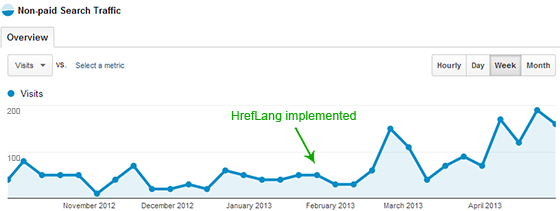We aim to respond to all messages within 1 business day. You'll be hearing from us soon!
In the meantime, perhaps you'd like to learn more...
International SEO: Why the Devil is in the Detail
SEO is not clear-cut - never has been and is even less so now. Answers to questions about the best tactics and approaches are often of the 'it depends' variety, particularly when it comes to International SEO strategies.
Technical decisions, business decisions, content decisions and cultural differences in marketing, user behaviour and so on all play a part. With so many factors involved and potential success or failure at stake, just how do you go about deciding which approach to take?
In this post I'll explore some international SEO scenarios I’ve been exposed to recently and present my recommended approach for each. I’ll also take a look at some key technical developments impacting multi-country SEO (including a mini case study about my experience with hreflang) and offer up some answers to a few of the more interesting international SEO questions I’ve been asked lately.
But First, Why Does International SEO Matter?
The consequences of choosing one approach over another are huge. Implementing successful multi-country and/or multi-lingual SEO involves making a number of technical / content / resource related decisions. They’re the kind of decisions that aren’t always easy to change down the track, so it’s highly preferable the right decisions are made at the outset of your project.
Get your approach wrong and you’ve got potential Google Panda / duplicate content / cloaking / ‘wrong site appearing in wrong geographic search result’ types of issues to contend with. Again, these issues are not always easy to fix; prevention is better than cure.
When it comes to choosing the right approach to your International SEO project there are a raft of factors to take into account:
- Whether you're a start-up or an established business/brand/website.
- The strength of your existing web presence overall and within target audience locations.
- Your available resources (time, money and human).
- Whether you're targeting a specific geographic location or a specific language, regardless of where that audience is located geographically i.e. are you targeting different languages in different countries, the same language in different countries, or different languages in the same country.
- Cultural, behavioural, usability, keyword, content, and other marketing related differences between locations e.g. (think about the differences between Europe vs Asia).
- Whether you have a physical presence and staff in your target location.
- Your future plans for expansion.
With factors like these involved, the first step is to get your research and planning locked down. It’s often the most overlooked phase of many web projects, but effort here will save you big time in the long run. Following that, you’re ready to start looking at the best way you can go about achieving your international SEO goals given the various options you've got.

Differences Between Multi-Language SEO and Multi-Country SEO
Before defining your international SEO strategy and approach you need to understand the differences between multi-country targeted websites and multi-language targeted websites. Multi-country websites target more than one country where the language used is largely the same, but the search engines used are likely to be different e.g. UK-based users using Google.co.uk and US-based users using Google.com
Multi-language websites target multiple languages at one time. Sometimes this can be necessary even when targeting only one country. For instance, in Belgium both French and Dutch are spoken depending on where you are in the country, hence it might be worthwhile creating content for each audience and targeting each language variation within separate sections of the same site.
Just to add another layer of complexity to the mix note that it's possible for a website to have a combination of multi-country and multi-language targeted content.
It's essential that search engines can easily crawl the various language or regional versions of your website. For this reason you need to be very careful when changing the language or content of a page using IP detection. I'll discuss this in some more detail below.
Three Core Approaches to Geotargeting
There are three main approaches used to geotarget a website, each with its own strengths and weaknesses as I’ll point out below.
1. Separate Top Level Domains
Use a Country Code Top Level Domain (ccTLD) for each international geographic area you want to target. E.g. www.examplesite.co.nz (for New Zealand) and www.examplesite.com.au (for Australia).
Pros:
- Delivers strongest signal to search engines that you are targeting a specific country.
- Can have positive impact on SERP click through rates and conversions resulting from improved trust / credibility within local market.
- Better chance of acquiring local links.
- Hosting server location less important as ccTLD sends strongest signal.
- Having a completely separate site for each location makes it easier to provide a totally customised experience that lends itself to the different needs, expectations and behaviours of each market.
- Can host each site in the specific country for improved user experience and better site response times.
Cons:
- Higher set up and ongoing maintenance costs. Each site is essentially a separate entity requiring its own unique SEO strategy (keyword research, content creation, community building/engagement, link development etc). This approach requires the most investment in time, money, and resources to achieve results.
- Failure to create quality, localised, unique copy for each site can result in none of your geo targeted ccTLD sites doing well.
- Some countries (e.g. France and Australia) require business identification before releasing domains.
I'd recommend the gTLD approach if…
You're a large international brand / organisation that serves several markets and has a significant budget and sufficient resources to promote each site on its own. If resources aren't too much of an issue this would be my recommended approach.
Also if you're targeting Russia or China then you’ll be best served by adopting a .ru or .cn domain name as both Yandex and Baidu (the dominant Search Engine in those respective markets) favour local domains.
2. Geo-targeted Subfolders
Use a Generic Top Level Domain (gTLD) such as 'www.examplesite.com' and target each international geographic area and language variation using subfolders e.g. 'www.examplesite.com/uk' (if targeting the UK) and 'www.examplesite.com/de' (if targeting Germany).
Pros:
- More economical than individual ccTLDs, from both a set up and maintenance perspective
- Strength from all inbound links points to one single main domain (‘example.com’) and flows through to individual subfolders
- Can use geotargeting settings in Google Webmaster Tools to indicate the preferred target country for each subfolder
Cons:
- Potential issues with getting the right content to rank in the right country. Recent developments with the use of hreflang attribute do provide a Google-specific solution (see mini case study below), as do Google's Webmaster Tools geo targeting settings. Also as long as you give visitors an obvious and easy route to get to the correct section of your site then it might not be such an issue for you if some of your UK specific content ranks in Australia.
- The subfolder approach requires a single server location as opposed to having separate servers located in each targeted country. This means you can't take advantage of speed benefits of hosting separate sites in same country as each target audience.
I'd recommend the subfolder approach if…
There are strict limitations on available resource (time, personnel and budget). Also if the brand isn't already strong internationally you're going to be busy enough attracting real links to one site, let alone multiple sites. Don't discount the fact though that over time you'll also want to be trying to build local inks to the relevant geo-targeted section of your site too, not just the main domain.
3. Geo-targeted Subdomains
Use a top level domain (e.g. 'www.examplesite.com') and target each international geographic area and language variation using sub domains e.g. 'uk.examplesite.com' and 'de.examplesite.com'.
Pros:
- As with subfolders, subdomains can use Google Webmaster Tools' geo targeting settings to indicate the preferred target country.
- Each subdomain can be hosted in the country you’re targeting.
Cons:
- Search engines consider subdomains and main domains to be separate sites. As separate sites they require independent content, link development, and promotion in their target geographic location = more resource required = higher costs.
- Like the subfolder approach, you may encounter issues with duplicate content and/or the wrong content ranking in the wrong geographic location if you don't have your hreflang attributes and Google Webmaster Tools set up correctly.
- Possible confusion for less tech savvy users accustomed to seeing www at the start of a URL.
I'd recommend the subdomain approach if…
Neither of the first two options was possible. In reality it’s not that simple and it’s not to say there aren't times when this might be a suitable approach for SEO reasons or reasons other than SEO e.g. say you want to run a specific promotional campaign for a fixed period of time, or perhaps your operate under a franchise model. However, I'm yet to be involved in a project where using subdomains made more sense than the alternatives, taking into account available resources, existing branding, and business goals.
Further to the three main options outlined above another alternative is to use URL parameters to deliver country or language specific content (e.g. www.examplesite.net/page-name?lang=es). There are a number of drawbacks to this approach and I’d suggest steering clear of it wherever possible.
A Note on Choosing a Domain Extension
When choosing a domain name it’s important to note that Google now treats some ccTLDs as gTLDs. Websites often use .co (the ccTLD for Columbia) as a generic domain rather than a country-targeted one, so it’s helpful to know that Google now treat .co as a generic domain and you can specify the country that it should be associated with.
At present there are 20 ccTLDs that also fall into the generic TLD (gccTLD) category:
| .ad | .as | .bz | .cc |
| .cd | .co | .dj | .fm |
| .gg | .io | .la | .me |
| .ms | .nu | .sc | .sr |
| .su | .tv | .tk | .ws |
If you’re adopting the separate ccTLD approach then make sure that the domain name you intend to use is available with the domain extension variation for each location you plan on targeting, either immediately or in the future. For a relatively small cost it’s worthwhile securing them now before someone else does. You want to avoid the brand dilution that comes from having to change domain name for one location because the extension isn’t available.
'So It Depends, Right? What Would You Suggest in the Following Situations?'
Well, it really does depend! Individual opinions may differ, but below are some scenarios from the real world along with my take on the most favourable approach for each.
Scenario 1
Type of business / website: Start-up women’s fashion focused e-Commerce site wanting to target multiple international markets.
Existing brand presence: Minimal
Available resource (time / budget / human): Low
Target audience: Predominantly English speaking users located in NZ, US and UK. Possibility of future growth into Asian markets.
Suggested approach: gTLD (www.examplesite.com) with subfolders targeting each geographic location (www.examplesite.com/nz/, www.examplesite.com/uk/)
Rationale: For a new brand and a new website, the process of creating and promoting strong content, engaging on social media, and attracting real links will take significant time and effort. Faced with limited resources I’d suggest focusing on one gTLD website and using subfolders to targeting specific markets. If business goes well and the company wants to forge ahead into Asian markets at a later date, then I'd suggest considering the use of separate ccTLDs for those countries.
Keep in mind: Watch out for cultural, product, usability and conversion related differences in different geographic locations, particularly if moving into Asian markets. Always try to use a local expert for keyword research, content creation and/or translation. Local professionals know the local market and its language and cultural idiosyncrasies.
Scenario 2
Type of business / website: New Zealand based engineering company with a well-established domestic brand looking to expand into the US, followed by the UK, Australia and Germany over time. Has an existing website (www.examplesite.co.nz) which is a strong local performer.
Existing brand presence: Medium/high within NZ market, low international presence
Target audience: US initially, then UK, Australia, Germany
Available resource (time / budget / human): Medium
Suggested approach: Create a new gTLD (www.examplesite.com) to be used for targeting the US and keep the existing .co.nz site as it is for the time being. Work on engaging with US audience and creating / promoting unique US localised content for the gTLD site. When ready for expansion to the UK, Australia and Germany, target these locations using subfolders (e.g. www.examplesite.com/uk/, www.examplesite.com/au/, www.examplesite.com/de/).
Alternatively you could opt to use ccTLDs for each location, but bear in mind the higher level of resources required to do so effectively.
Rationale: Ranking a .co.nz domain in another region like the US or UK is a tough ask. If you've got ample resource (e.g. a strong team dedicated to content creation, social media, brand building, link development etc) then I’d suggest using a .com to target the US and use ccTLDs for the remainder of locations you're looking to target e.g .co.uk, .com.au, and .de
If you don't have ample resource (as is the case in this scenario), then by using a gTLD (.com) and subfolders for countries outside of New Zealand you'll cover your bases while not spreading yourself too thin trying to get a foothold with individual websites that each require their own content, promotion, link development, and maintenance.
In time you might decide to redirect the .co.nz domain to a www.examplesite.com/nz/ subfolder for sake of consistency and ease of maintenance.
Keep in mind: While domain level link juice does flow to subfolders, you'll still need to build links to the relevant subfolder in your site from each of the countries you’re targeting.
Scenario 3
Type of business / website: Established power tools brand currently using .com gTLD but wanting to expand into multiple languages and geographic targets.
Brand presence: Strong
Available resource (time / budget / human): High
Target audience: Global
Suggested approach: Separate ccTLD for each targeted location
Rationale: Having a strong brand presence means it's probably going to be easier to develop decent links, especially as they've also got the resources required to create, publish and promote unique localised content. In some markets (e.g. France, Asia) it will also be easier to attract links using ccTLDs.
Keep in mind: There are just as many examples of globally recognised brands using the separate site approach successfully (e.g. Sony) as there are those using the subfolder approach to great effect (e.g. Apple). Then there are others like BMW who are using a blend of both approaches. Just because these heavy hitters do it one way doesn't mean you should follow suit; what works for them might not work for you. After all, there's plenty of talk around at the moment about how far big brands can push the boundaries, get caught, and yet still recover.
Technical Aspects of International SEO
Despite SEO’s growing technical complexity, some things are becoming clearer (believe it or not!). Search engines are giving better guidance as to how to approach and handle the prospect of marketing websites to different geographic and language targeted audiences. We’ve also got some really useful tools at our disposal to help us designate specific content for local markets. Below are details of some of the technical elements you’ll want to take care of when implementing your international SEO strategy.
XML Sitemaps
I'm a fan of using XML sitemaps, even for smaller sites. Sure a well-structured site should get indexed just as accurately without the help of an XML sitemap, but they’re pretty easy to set up and can be used to deliver search engines additional information about your site (e.g. page priority, lastmod, changefreq). I’m yet to experience a situation that would make me think twice about using them for the majority of projects I work on.
For international SEO projects it’s worthwhile creating and submitting a separate XML sitemap for each subdirectory or subfolder. Separate sitemaps make it much easier to diagnose and fix indexation issues, plus they offer a great medium for implementing the hreflang attribute I refer to later in the post.
Google Webmaster Tools Geo-Targeting
If you take the subfolder (or subdirectory) route Google Webmaster Tools lets you register and verify each subfolder / subdirectory separately. Do it and be sure to designate the correct geographic target for each subfolder - here's how.
Hosting Location
If you're using a ccTLD or geo targeting via Webmaster Tools then from an SEO point of view server location isn’t a major factor.
"If your site has a geographic TLD/ccTLD (like .co.nz) then we will not use the location of the server as well. Doing that would be a bit confusing, we can't really "average" between New Zealand and the USA… At any rate, if you are using a ccTLD like .co.nz you really don't have to worry about where you're hosting your website, the ccTLD is generally a much stronger signal than the server's location could ever be."
- John Mueller, Senior Webmaster Trends Analyst, Google -
Having said that, page speed is certainly important and server location can have an impact on that, so there are clear benefits of hosting near your audience. The key thing is that you go with a reputable provider that's fast, has 99.9% uptime, and great support should you need it.
Hreflang Attributes – a Case in Point
The hreflang attribute tells Google that a specific page is targeted to a specific location, language, or both. For example, let's say you're targeting different English speaking countries separately with the same/similar content. By using the rel="alternate" hreflang="x" annotation (where "x" = country and language code of the target geo location) you can help Google understand which URL you would prefer them to show users in each relevant location.
As there's already plenty of useful stuff around about implementing hreflang instead I'll take you through my experience using it and the results I've seen.
The Brief
A client came to us recently wanting help with their geo targeted ccTLDs – a '.com.au' site targeting Australia and a separate .co.nz site targeting New Zealand. The '.co.nz' domain was slightly older and consistently outranked the .com.au site for searches (including brand name searches) on Google.com.au. The '.com.au' website was hosted in Australia and had a variety of Australian-based links pointing at it. The content on both websites was very similar and the sites also shared a couple of the same links, something which isn't ideal but it’s what we had to work with.
What We Did
Following a full audit of both websites our first step was to rework the Australian website's content, making it as unique as possible and better targeted to their target audience within that country. Due to various limitations client-side we weren't able to make all content as unique as we would have liked, but as is often the case it’s a matter of working with what you've got. We also fixed a number of thin pages by improving depth of content, amalgamating some content, and in some cases removing pages deemed to be low value.
Initial Results.... Not Much Improvement
8 weeks after implementing our initial content focused changes, we still weren't seeing stable improvement despite various Google updates rolling out during this time. The .co.nz site was still showing up regularly in Google.com.au and the .com.au site was nowhere to be seen except for elaborate long-tail searches.
Where to Next?
With little improvement coming from our content related fixes the next step was to implement the hreflang attribute and in doing so send another signal that the .com.au pages were specifically intended for an Australian audience. I would have thought the .com.au domain extension would have been a strong enough signal in itself, but the content similarity and shared links may have been too much for Google to ignore.
Now We’re Getting Somewhere :)
4 weeks after implementing the hreflang annotation, the .com.au website started to appear consistently in Google.com.au results, with no sign of the .co.nz site.
Google Webmaster Tools is now also showing a sharp rise in impressions, the date of which directly correlates with our implementation.
10 Weeks On
The Australian targeted site continues to maintain its higher impression numbers and traffic is on the rise as a result of its improved visibility.
The performance of the New Zealand site has also improved within New Zealand, yet this is most likely a result of the content improvements made on the New Zealand website at the same time.
International SEO and Bing
At present Bing doesn't support hreflang and until late April 2013 they also didn't have the option of setting your preferred location via their Webmaster Tools console. It's great to finally see Bing adding geo-targeting functionality; the degree of flexibility they offer when it comes to choosing which level of your site you want to target to each different audience is awesome (e.g. the domain level, the subdomain level, the directory level or the page level). Read more about it here.
Bing also do take the language meta tag into account, so make sure this is set properly for all pages on all sites.
In the past this was done using <meta
http-equiv="content-language" content="xx"> (where "xx" is the country code of the target audience), however in accordance with current W3C standards this should now form part of the HTML lang attribute instead e.g. <html lang="xx">
International SEO FAQs
Below I’ve compiled a few International SEO questions we’ve been asked or have discussed in-house over the past few months. Don't see an answer to your question? Drop a comment and I’ll do my best to give you the information you need.
Is translated content considered duplicate?
No, Google consider the same content in English to be different to the same content in German. Bear in mind it's never a good idea to use an automatic translator to automatically generate foreign language content for your site.
Is it possible to geo target with a Content Distribution Network (CDN)?
From an SEO point of view I don’t see an issue with using CDNs provided you’re using either a ccTLD or applying the correct Google Webmaster Tools geo targeting to indicate your preferred target location. Additional benefits like increasing access bandwidth and reducing access latency for crawlers and users means faster speed, which can only be good for SEO.
As mentioned previously, hosting location isn’t a definitive signal for Google.
"Server location (through the IP address of the server) is frequently near your users, however some websites use distributed content delivery networks (CDNs) or are hosted in a country with better webserver infrastructure, so we try not to rely on the server location alone."
- John Mueller, Senior Webmaster Trends Analyst, Google -
What about using IP detection to serve localised content?
Despite seemingly being good for users try to avoid using IP detection and redirects to serve location or language targeted content. IP detection is not always accurate and given that Google crawls from a US based IP location you run the risk of not getting some of your content crawled at all if it is not made available to US users. Let's say you're targeting the US, Australia and the UK and serving localised content based on IP detection and redirects. Chances are that when Googlebot crawls your site it will get served the US specific content, but not the UK or Australian content.
If IP detection is your only option, then make sure users and search engines can access alternative versions of your site regardless of their location. For search engines you might choose to include crawlable text links to other alternative locations and for users you can let them choose their preferred location once they're arrive at your site. Use cookies to ensure a user’s preference is maintained for future visits.

Whatever you do, don’t let incorrectly implemented IP detection and redirect scripts stop your site from being completely and correctly crawled and indexed in the first place.
Note that Google and Yandex have both recently unveiled additional support for the hreflang attribute making it possible for webmasters to specify the default version of country selector/redirector homepages that don’t target any specific language or location. Learn more about it here.
How should I populate title tags & meta descriptions on multi-language websites?
If you're working on a multi-language site your best bet is to give each page a unique title tag and meta description written in the language you’re targeting with that page. It's important for a number of reasons; think better click through rates, better relevance, higher potential for attracting local links, more credibility / trust, plus it'll prevent you getting hundreds of duplicate page title and meta description notices in Google Webmaster Tools.
If you're working on an English language site targeting different English speaking locations using subfolders/subdomains (e.g. US and UK) then there’s also value to be gained in tailoring page titles and meta descriptions to the language nuances of each audience.
Make sure you get your content professionally translated – don’t rely on automatic translation tools to provide you with accurately translated page titles and meta descriptions!
Aside of things technical things like ccTLDs, XML sitemaps, hreflang etc, what else can I do to signal I’m targeting a specific location?
Other factors that can help with geo targeting include having a physical addresses in the target location, displaying a local phone number, having a Google+ Local listing, and using the appropriate currency format (if relevant).
Don’t forget that inbound links from your target location and language are essential too.
Is it OK to mix different languages on the same page?
Generally speaking the answer is no. Say you’ve got a site targeting English users and German users, then do your best to make sure that all of the content in the German section of the site is translated into German, including the navigation and any buttons, banners and so on. First and foremost it’s better for the user, plus it reduces confusion for search engines.
To conclude...
The potential upside from successfully expanding into new countries and attracting new customers is massive, particularly for businesses in places like New Zealand where population size and geographic isolation can be a barrier to growth. Just remember that when it comes to using your website to support your plans for international expansion, the devil really is in the detail.
If I can leave you with only a few key points it is these:
- Do extensive research up front; plan meticulously, develop your strategy and identify your goals before making any firm decisions of a promotional or technical nature.
- Make sure whomever is responsible for your web development understands the implications of each approach to geo-targeting. Don't let them choose a solution in isolation - seek expert advice from people who really know about search engines.
- Develop a thorough understanding of the online competition in each market you're looking to target. Which sites rank? What tactics do they use? Where does the local audience hang out online?
- Fully comprehend the level of resources you’ll need to support your chosen approach - don't get caught short.
- Finally, don't underestimate the benefits of using local people on the ground to help maximise your chances of successful expansion into new markets, particularly those you’re not intimately familiar with.
If you’re currently in the throes of tackling a multi-country or multi-lingual SEO project then I hope you’ve gleaned a few nuggets here that’ll help you on your way. For those who have already been down this path, drop a comment below and share your stories of international SEO success, failure or otherwise – I’d love to hear your insights and learn more about your experiences.
Recommended Reading
If you want to dive deeper into International SEO there are a number of great posts around that’ll set you on your way. Get started by checking out these posts:
- http://www.seerinteractive.com/blog/international-seo-strategy-guide
- http://www.seomoz.org/blog/international-seo-dropping-the-information-dust
- http://www.searchenginepeople.com/blog/mastering-the-art-of-international-seo.html
Written by Mark Vassiliou
Mark is the Manager of Digital Marketing at Apex and has worked in the digital marketing industry since 2004. Prior to joining Apex he worked in a variety of traditional marketing roles in both the corporate and SME environment in NZ and abroad, but these days much prefers the tangible measurability and transparency of digital marketing.Related posts
Add a comment16 Comments
Thanks for the great article. I am really looking for this kind of info for long time. Its definitely a valuable info for International SEO Projects. But I was confused on Syntax part of rel="alternate" hreflang="x".
For Example: One of my client is having their Main Business on UK. Now they are opening 4 branches in diff countries.
1. Default website is www.xyz.com/uk
Now they have sub directories as www.xyz.com/it, www.xyz.com/fr and other 2 countries(spain and italy). Now I want to target each country with their respective languages. I have to start my ground work like Webmaster Integration and Sitemap updates. Can you explain me with a Proper syntax for my above example. Awaiting for your reply.
Once again thanks for the great info. Cheers :)
There are a few ways you can implement this. One would be to add the following to the <head> section of each page that is available across each of the geo-targeted subdirectories. For example on the home page of each subdirectory you would add:
<link rel="alternate" hreflang="en "href="http://www.xyz.com/uk" />
<link rel="alternate" hreflang="it" href="http://www.xyz.com/it" />
<link rel="alternate" hreflang="es" href="http://www.xyz.com/es" />
<link rel="alternate" hreflang="fr" href="http://www.xyz.com/fr" />
You’ll need to include the relevant variation of this code on each page in each section of your sites (not just on the home page of each subdirectory as is shown in the example above) i.e. you need to swap out the URLs to reflect the relevant page.
Depending on your set up you might find it easier to implement hreflang using XML sitemaps instead. Here’s an example - http://support.google.com/webmasters/bin/answer.py?hl=en&answer=2620865&topic=2370587&ctx=topic
Hope that helps!
I spend most of my daily hours browsing and writing about international SEO and rarely do I come across posts that provide this level of depth.
You're right that there are already many great resources out there on rel-alternate-hreflang, however we've (Webcertain) come to find that great confusion still surrounds the tags. So we set out to create a super visual (40+ page) guide to the hreflang attribute, in effect making it much more digestible.
You can get it for free here: http://internationaldigitalhub.com/en/publications/the-essential-guide-to-rel-alternate-hreflang
Great write up. We are a long established UK company and just opened up in Australia. Have got http://www.jayex.com.au and created a site with mostly common (duplicated pages), but was told by my SEO company to take it down as it was bad for SEO. He said do a different design, different photos, different content and URLs. But we want it have the same branding and common content. Any suggestions ?
I'm speechless. This guide made everything on international SEO on the Moz blog look just like a kind of teasers. You did a really great job!
I'll read other posts, and I think my opinion will lead me to subfolders, but we'll see !
Well, thank you !
Very detail, informative, and clearly explained!
Mark, I have a case regarding this language-country-confusing SEO and hope you can help a bit. I'm from Indonesia and the Google here is Google.co.id which provides 4 language options:
- Google.co.id in English
- Google.co.id in Bahasa Indonesia
- Google.co.id in Basa Jawa
- Google.co.id in Basa Bali
As we know it, each option displays different results. Now I have a client (TLD is .co.id) that want to target Google.co.id in English. The problem is, Google.co.id in English prioritizes English-websites in its search results, making it difficult for my client's website to rank on Google.co.id in English.
The question is:
How to target for specific language (i.e. English in this case) while the Google used is Google.co.id? Is this sort of case where I have to implement hreflang tag?
Thank you Mark and have a nice day! :)
AWESOME! LET'S GET STARTED
TELL US HOW WE CAN HELP
We aim to respond to all messages within 1 business day. You'll be hearing from us soon!
In the meantime, perhaps you'd like to learn more...








